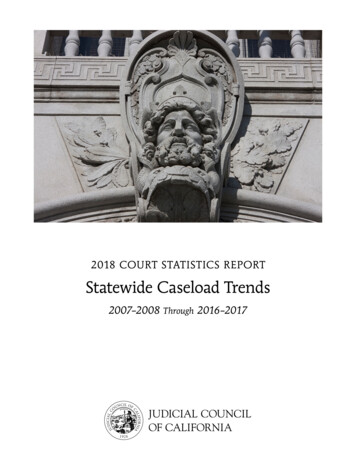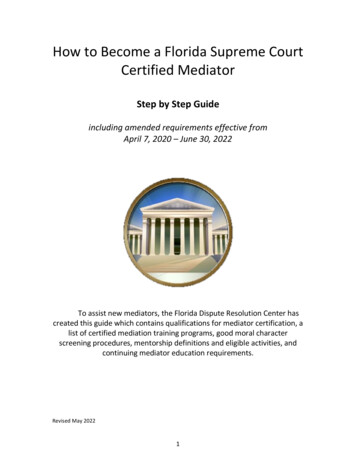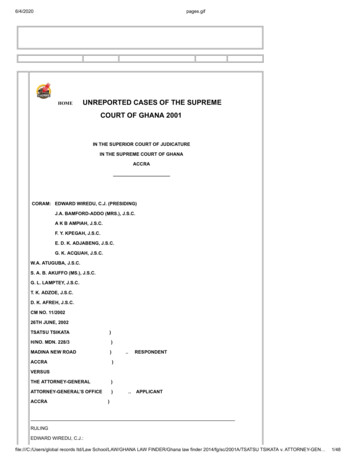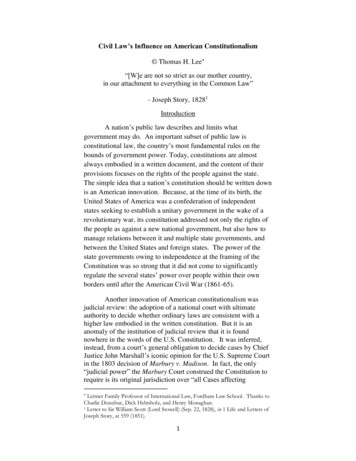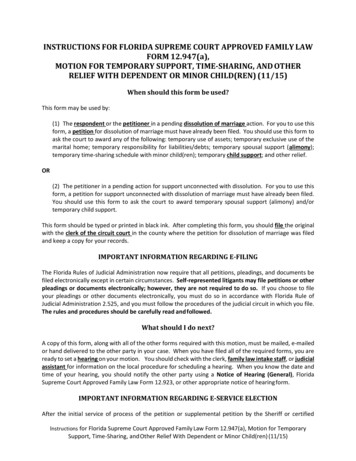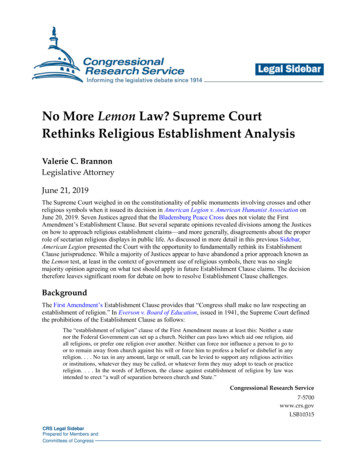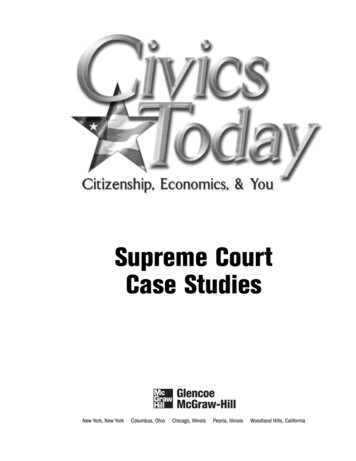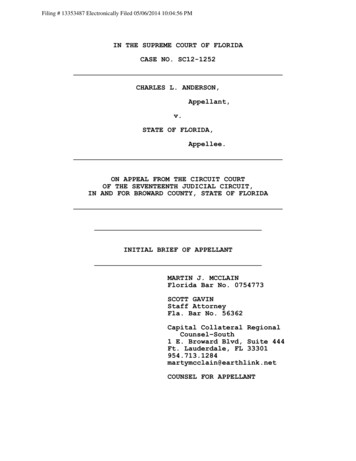
Transcription
Filing # 13353487 Electronically Filed 05/06/2014 10:04:56 PMRECEIVED, 5/6/2014 22:08:46, John A. Tomasino, Clerk, Supreme CourtIN THE SUPREME COURT OF FLORIDACASE NO. SC12-1252CHARLES L. ANDERSON,Appellant,v.STATE OF FLORIDA,Appellee.ON APPEAL FROM THE CIRCUIT COURTOF THE SEVENTEENTH JUDICIAL CIRCUIT,IN AND FOR BROWARD COUNTY, STATE OF FLORIDAINITIAL BRIEF OF APPELLANTMARTIN J. MCCLAINFlorida Bar No. 0754773SCOTT GAVINStaff AttorneyFla. Bar No. 56362Capital Collateral RegionalCounsel–South1 E. Broward Blvd, Suite 444Ft. Lauderdale, FL 33301954.713.1284martymcclain@earthlink.netCOUNSEL FOR APPELLANT
PRELIMINARY STATEMENTCitations in this brief to designate references to therecords, followed by the appropriate page number, are as follows:“R. ” - Record on direct appeal to this Court from the1986 trial;“PC-R. ” - Record on appeal to this Court from the Rule3.851 proceedings;All other citations will be self-explanatory or willotherwise be explained.REQUEST FOR ORAL ARGUMENTMr. Anderson has been sentenced to death.The resolution ofthe issues in this action will determine whether Mr. Andersonlives or dies.This Court has not hesitated to allow oralargument in other capital cases in similar procedural posture.Afull opportunity to air the issues through oral argument would beappropriate in this case, given the seriousness of the claimsinvolved and the stakes at issue.Mr. Anderson, through counsel,accordingly urges that the Court permit oral argument.i
TABLE OF CONTENTSPagePRELIMINARY STATEMENT. . . . . . . . . . . . . . . . . . . . . iREQUEST FOR ORAL ARGUMENT. . . . . . . . . . . . . . . . . . . iTABLE OF CONTENTS. . . . . . . . . . . . . . . . . . . . . .iiTABLE OF AUTHORITIES. . . . . . . . . . . . . . . . . . . . .ivSTATEMENT OF THE CASE AND FACTS. . . . . . . . . . . . . . . . 1STANDARD OF REVIEW. . . . . . . . . . . . . . . . . . . . . .25SUMMARY OF ARGUMENT. . . . . . . . . . . . . . . . . . . . .25ARGUMENT. . . . . . . . . . . . . . . . . . . . . . . . . . .28ARGUMENT ITHE CIRCUIT COURT ERRED IN DENYING MR. ANDERSON’SINEFFECTIVE ASSISTANCE OF COUNSEL AT THE GUILT PHASE OF HISCAPITAL TRIAL CLAIM WITHOUT CONDUCTING AN EVIDENTIARYHEARING. . . . . . . . . . . . . . . . . . . . . . . . . 28A.Introduction. . . . . . . . . . . . . . . . .28B.Mr. Anderson’s Guilt Phase IneffectivenessClaim. . . . . . . . . . . . . . . . . . . . .33C.The Circuit Court’s Order Denying the ClaimWithout the Benefit of Evidentiary Development. 68ARGUMENT IIMR. ANDERSON’S SENTENCE OF DEATH STANDS IN VIOLATION OF RINGV. ARIZONA AND THE SIXTH, EIGHTH AND FOURTEENTHAMENDMENTS . . . . . . . . . . . . . . . . . . . . . . . 78ARGUMENT IIILAW ENFORCEMENT DESTRUCTION OF THE MURDER WEAPON AND OTHERMATERIAL EXCULPATORY EVIDENCE VIOLATED MR. ANDERSON’S RIGHTSTO DUE PROCESS AS DEFINED BY BRADY V. MARYLAND AND ITSPROGENY, AND HIS RIGHTS UNDER THE FIFTH, SIXTH, EIGHTH, ANDFOURTEENTH AMENDMENTS TO THE UNITED STATES CONSTITUTION ANDCORRESPONDING PROVISIONS OF THE FLORIDA CONSTITUTION. . 90ARGUMENT IVNEWLY DISCOVERED EVIDENCE ESTABLISHES THAT THE FORENSICSCIENCE USED AS EVIDENCE TO SUPPORT MR. ANDERSON’S DEATHSENTENCE WAS NEITHER RELIABLE NOR VALID, THUS DEPRIVING HIMii
OF HIS RIGHTS UNDER THE FIFTH, SIXTH, EIGHTH, AND FOURTEENTHAMENDMENTS TO THE U.S. CONSTITUTION. . . . . . . . . . 95CONCLUSION. . . . . . . . . . . . . . . . . . . . . . . . . .97CERTIFICATE OF SERVICE. . . . . . . . . . . . . . . . . . . .98CERTIFICATION OF TYPE SIZE AND STYLE. . . . . . . . . . . . .98iii
TABLE OF AUTHORITIESPageAnderson v. Florida,540 U.S. 956 (2003). . . . . . . . . . . . . . . . . . .Anderson v. State,841 So. 2d 390 (Fla. 2003). . .1510, 11, 14, 64, 78, 79, 86Apprendi v. New Jersey,530 U.S. 466 (2000). . . . . . . . . . . . . . . . . . .Arizona v. Youngblood,488 U.S. 51, 58 (1988). . . . . . . . .7827, 90, 91, 93, 94Baze v. Rees,128 S. Ct. 1520 (2008). . . . . . . . . . . . . . . . .21Beverly Beach Properties v. Nelson,68 So. 604 (Fla. 1953). . . . . . . . . . . . . . . . .80Blakely v. Washington,542 U.S. 584 (2002). . . . . . . . . . . . . . . . . . .78Blanco v. State,702 So. 2d 1250 (Fla. 1997). . . . . . . . . . . . . . .25Bleau v. Wall,808 A.2d 637, 643 (R.I. S.C. 2002). . . . . . . . . . .45Bottoson v. Moore,833 So. 2d 693 (Fla. 2002). . . . . . . . . . .86, 87, 88Brady v. Maryland,373 U.S. 83 (1963). . . . . . . . . . . . . . . . .Bryant v. State,901 So. 2d 810 (Fla. 2005). . . . . . . . . . . .California v. Trombetta,467 U.S. 479 (1985). . . . . . . . . . . . . . .69, 9019, 73-427, 90, 91Daubert v. Merrell Dow Pharmaceuticals, Inc.,509 U.S. 579 (1993). . . . . . . . . . . . . . . . . . .45Davis v. State,875 So.2d 359 (Fla.2003). . . . . . . . . . . . . . . .88Doorbal v. State,837 So. 2d 940 (Fla. 2003). . . . . . . . . . . . . . .88iv
Frye v. United States,293 F. 1013 (D.C. Cir. 1923). . . . . . . . . . . . . .Gaskin v. State,737 So. 2d 509 (Fla. 1999). . . . . . . . . . . . .25, 72Gore v. State,784 So. 2d 418 (Fla. 2001). . . . . . . . . . . . . . .Guzman v. State,868 So. 2d 498 (Fla. 1993)). . . . . . . . . . . . .4892, 94Henry v. State,862 So.2d 679 (Fla. 2003). . . . . . . . . . . . . . . .Hinton v. Alabama,134 S.Ct. 1081 (2014). . . . . . . . . . . .428820, 31, 32, 35Hurst v. State,18 So. 3d 975 (Fla. 2009). . . . . . . . . . . . . .31, 33Illinois v. Fisher,540 U.S. 544 (2004). . . . . . . . . . . . . . . . .90, 92Israel v. State,837 So. 2d 381 (Fla. 2002). . . . . . . . . . . . . . .Johnson v. State,465 So. 2d 499 (Fla. 1985). . . . . . . . . . . . .83, 89Johnston v. State,863 So.2d 271 (Fla. 2003). . . . . . . . . . . . . . . .88Kennedy v. Louisiana,554 U.S. 407 (2008). . . . . . . . . . . . . . . . . .King v. Moore,831 So. 2d 143 (Fla. 2002). . . . . . . . . . . . .8835-686, 87Kormondy v. State,845 So. 2d 41 (Fla. 2003). . . . . . . . . . . . . . . .88Kyles v. Whitley,514 U.S. 419 (1995). . . . . . . . . . . . . . .30, 33, 69Lightbourne v. Dugger,549 So. 2d 1364 (Fla. 1989). . . . . . . . . . .25, 33. 72Lightbourne v. McCollum,969 So. 2d 326 (Fla. 2007). . . . . . . . . . . . . . .v21
Lugo v. State,845 So. 2d 74 (Fla. 2003). . . . . . . . . . . . . . . .88Mann v. State,453 So. 2d 784 (Fla. 1984). . . . . . . . . . . . . . .83Melendez-Diaz v. Massachusetts,129 S. Ct. 2527 (2009). . . . . . . . . . . . . . . . .22Mills v. Moore,786 So. 2d 532 (2001). . . . . . . . . . . . . . . . . .86Muehlman v. State,3 So. 3d 1149 (2009). . . . . . . . . . . . . . . .79, 80Owen v. State,696 So. 2d 715 (Fla. 1997). . . . . . . . . . . . . . .Parker v. State,89 So. 3d 844 (Fla. 2011). . . . . . . . . .8030, 31, 69, 76Parker v. State,873 So. 2d 270 (Fla. 2004). . . . . . . . . . . . .79, 80Peede v. State,748 So. 2d 253 (Fla. 1999). . . . . . . . . . . . . . .25Preston v. State,444 So. 2d 939 (Fla. 1984). . . . . . . . . . . . . . .80Ramirez v. State,651 So. 2d 1164 (Fla. 1995). . . . . . . . . . . . .Ramirez v. State,810 So. 2d 836 (Fla. 2001). . . . . .42, 4343-4, 45, 66-7, 76-7Rhodes v. State,986 So. 2d 501 (Fla. 2008). . . . . . . . . . . . .45, 72Ring v. Arizona,536 U.S. 584 (2002). . . . . . . . . . . . . . . . .16, 78Rodriguez de Quijas v. Shearson/American Express,490 U.S. 477 (1989). . . . . . . . . . . . . . . . . . .87Schriro v. Summerlin,542 U.S. 348 (2004). . . . . . . . . . . . . . . . . . .87Schoenwetter v. State,46 So.3d 535 (Fla. 2010). . . . . . . . . . . . . . . .29vi
Smith v. State,866 So.2d 518 (Fla.2004). . . . . . . . . . . . . . . .88Smith v. State,75 So. 3d 205 (Fla. 2011). . . . . . . . . . . . . . . .23State v. Akins,69 So. 3d 261 (Fla. 2011). . . . . . . . . . . . . . . 79-80Strazzulla v. Hendrick,177 So. 2d 1, 3, (1965). . . . . . . . . . . . . . . . 79-80Strickland v. Washington,466 U.S. 668 (1984). . . . . . . . . . . .28, 29, 69, 71-2Sweet v. State,624 So. 2d 1138 (Fla. 1993). . . . . . . . . . . . .12, 82United States v. Bagley,473 U.S. 667 (1985). . . . . . . . . . . . . . . . . . .69United States v. Brown,9 F.3d 907 (11th Cir. 1993). . . . . . . . . . . . . . .91Wyatt v. State,71 So. 3d 86 (Fla. 2011). . . . . . . . . . . . . .vii23, 45
STATEMENT OF THE CASE AND FACTSThe Circuit Court for the Seventeenth Judicial Circuit, inand for Broward County, Florida entered the judgments ofconvictions and death sentence currently at issue.On September 8, 1994, Mr. Anderson was indicted for onecount of first-degree murder in the death of Keinya Smith (R. 1).Ms. Smith’s body had been found on the morning of January 17,1994.1Ms. Smith was Mr. Anderson’s stepdaughter.In the courseof the murder investigation, Mr. Anderson was arrested for aprobation violation arising out of Miami-Dade County.Theviolation of probation affidavit was filed on January 25, 1994,and Mr. Anderson arrested.On April 7, 1994, Mr. Anderson’sprobation was revoked and he was ordered imprisoned for 20 yearson eleven counts of attempted sexual battery on a person lessthan twelve years of age under Fla. Stat. §794.011(2).21Ms. Smith was born on October 12, 1975 (R. 2643).the time of her death she was nineteen years of age.2AtThe victim in the Miami-Dade County attempted sexualbattery case was Keinya Smith. After Mr. Anderson revealedsexual misconduct with his stepdaughter during treatment for hisdrug addiction, law enforcement was notified in September of 1992(R. 2740-41). The investigating officer learned that Ms. Smithhad brought the improper sexual contact to her mother’s attentionseveral years earlier (R. 2741). Her mother, Edwina Anderson,acknowledged that Ms. Smith had advised her of improper sexualcontact at least two years before law enforcement was contactedby the drug treatment center regarding Mr. Anderson’s admission(R. 2657). Edwina did not contact the authorities even thoughMr. Anderson admitted that misconduct had occurred when she askedhim. Instead, Edwina wanted to keep her family together (R.2658). The family included Keinya who had been born in 1975, Mr.Anderson, who she had married in 1980, and her three children whoMr. Anderson had fathered during their marriage (R. 2662). Afterlaw enforcement commenced its investigation, charges were brought1
When the indictment was filed on September 8, 1994, an orderwas also entered directing Mr. Anderson’s return to BrowardCounty to face the charge.On January 31, 1995, a short arrestinformation form was filed in the circuit court (R. 11).OnFebruary 7, 1995, Mr. Anderson completed an affidavit ofindigency, and an order was entered appointing the publicdefender’s office to represent Mr. Anderson (R. 13).On February9, 1995, Mr. Anderson’s case was assigned to Assistant PublicDefender, Timothy Day (PC-R. 4168).Subsequently, he had askedthe public defender’s office to provide another attorney to workon Mr. Anderson’s case with him (PC-R. 4172).Thereafter, MindySoloman was assigned to assist him in Mr. Anderson’s case.3InFebruary of 1996, Mr. Day retained the services of a forensicsexpert, Peter Deforrest, for services in Mr. Anderson’s case(SuppPC-R. 2881).In addition, Mr. Day provided Dr. Deforrestwith photos and lab reports to begin to review in February of1996 (SuppPC-R. 2875).Later in July of 1996, Mr. Day sent Dr.Deforrest a videotape that he had requested and luminal photos.Mr. Day asked Dr. Deforrest to review the material in order toagainst Mr. Anderson in Miami-Dade County. Mr. Anderson wasarrested on October 2, 1992, and an information was filed onOctober 22, 1992. With the support of Edwina and Keinya, theState agreed to a plea bargain with Mr. Anderson (R. 3126). Inexchange for a guilty plea to eleven counts of attempted sexualbattery with a minor, the State agreed that Mr. Anderson shouldbe given probation. The plea was entered on November 24, 1992.3Mindy Soloman was elected as Broward County Court Judgein 2010. However in order to avoid confusion, she will bereferred to as Ms. Soloman in this brief. Doing so is not meantto be disrespectful to Judge Soloman in any way.2
help Mr. Day prepare for depositions of the crime scenetechnicians (SuppPC-R. 2876).In April of 1997, after havingbeen hired by the Federal Public Defender’s Office, Mr. Day leftthe Broward County Public Defender’s Office (PC-R. 2084).After Mr. Day’s departure, Ms. Soloman was left as Mr.Anderson’s counsel.The public defender’s office then assignedGeorge Reres to work on Mr. Anderson’s case with Ms. Solomon (PCR. 4190, 4201).According to Ms. Soloman, sometime thereafterMr. Reres told her “you should get off this case” (PC-R. 4198).4About the same time, she was promoted to be a chief assistantwithin the public defender’s office, and she removed herself fromthe case in July of 1997 (PC-R. 2084).Ms. Soloman was unable torecall or recognize the transfer memo that appeared to have beenprepared by her when she departed Mr. Anderson’s case (PC-R.4195).5In a memo for file transfer (which was the standard wayfor an attorney getting off a case to pass information to otherattorneys who would be handling the case in the future), Ms.Soloman wrote that the “case is a nightmare” (SuppPC-R. 2885).She then outlined what needed to be done which includeddepositions of the forensic detectives and relatives of the4The State elicited this testimony during theevidentiary hearing below on the penalty phase ineffectivenessclaim. However, no testimony was elicited as to why Mr. Rerestold Ms. Soloman that she should “get off this case.”5Ms. Soloman indicated that “[a]bsolutely,” the transferappeared to have been one prepared by her in Mr. Anderson’s case(PC-R. 4193). However because Ms. Soloman did not recognize thedocument the judge sustained the State’s objection to theadmission of the transfer memo (PC-R. 4194).3
victim.She then stated: “Need to bring down our expert in fiberand blood before we depose the forensic guys.”She also notedthat “Have invest. getting us photos of cars that the witnessessay they thought they saw so we can compare to our clients car”(SuppPC-R. 2885).With Ms. Soloman’s departure from the case, Mr. Reres wasleft as Mr. Anderson’s only counsel.Mr. Reres indicated that heand Ms. Soloman had not made “a real firm decision as to whowould handle what at the point in time that she left the case”(PC-R. 4201).Up to the point of her departure both Ms. Solomanand Mr. Reres had been participating in every aspect of the case(PC-R. 4202).The focus up to that point had been on the guiltphase of the case, although he believed just before her departurethere had been a discussion about his need to focus more on thepenalty phase (PC-R. 4206).Sometime after Ms. Soloman’s departure from Mr. Anderson’scase, Ed Hoeg was assigned by the public defender’s office towork on the case with Mr. Reres.As Mr. Reres explained:The case was kind of thrust upon Ed. I’m not sure hewas thrilled to have it under the circumstances. Iknow he was very busy with other cases or other caseload. I think he had a much more substantial case loadthan I did at the time.I had been focusing more on homicide at that point inmy career. He was starting to focus on homicide butstill ha[d] a very full floater case load in ouroffice, which was a wide variety of serious charges infront of all the judge in Broward County.So it was a difficult [sic] for him to put a lot ofeffort into the case and time into the case early on.4
(PC-R. 4209).As to the division of labor between them, Mr.Reres has testified that:[I]t was not my decision how to break up theresponsibility. Nor was it Ed’s at the time. Ibelieve that the administration of the PublicDefender’s Office decided that Ed would try the guiltphase and I would focus on the penalty phase.(PC-R. 4210).Mr. Reres recalled going with Mr. Hoeg to meet Mr. Andersononce when he first introduced Mr. Hoeg to Mr. Anderson.Mr.Reres tried repeatedly to get Mr. Hoeg go back with him to meetwith Mr. Anderson; however, it never worked out (PC-R. 4213).Mr. Reres explained:I don’t think I learned until pretty close to trialthat he really hasn’t seen Charles much, if at all, onhis own. I think there was a couple of times thatyear, year and a half period of time that he was on thecase.(PC-R. 4213).Mr. Reres elaborated:I think really the whole time that Ed was on the case,Charles continued to express concerns about Ed notseeing him. I continued to have conversations withCharles about the guilt phase even well after I hadbeen relegated to the penalty phase.I continued to share with Charles factors about theguilt phase investigation, what I felt would bepresented on his behalf expecting that Ed would largelyadopt the same strategy that I had sort of adopted forMindy and Tim, which was to make a vigorous challengeof the circumstantial evidence through calling our ownwitnesses, challenging the State’s witnesses, doing avariety of things that would seem to me was the bestway to handle this type of case, this type of evidence.(PC-R. 4214).Mr. Reres did have conversations with Mr. Hoeg.his recollection of those conversations was:5However,
I think our conversations were largely one sided. Ithink I was telling Ed why I thought this needed to bedone and that needed to be done and him smiling noddinghis head and saying okay.But in terms of watching, you know, in terms of makingsure Ed was actually going to do that or sitting downwith him and getting him to commit to exactly what hewas going to do, I didn’t do that.(PC-R. 4214).Mr. Anderson’s trial began on February 3, 1999 (R. 965).6The State’s case was circumstantial and included witnesses whowere called as experts to testify regarding: matching one tireimpression from where the body was found as consistent with onetire on Mr. Anderson’s car; a grease pattern on the victim’sclothing as possibly made by a coil spring that was part of theundercarriage of Mr. Anderson’s car; and one fiber found underMr. Anderson’s car that microscopically matched the fibers of thepants that were one the victim’s body.When the State rested at the conclusion of its case-in-chiefpresentation on February 10, 1999, Mr. Hoeg indicated that he was“a little bit surprised” by the State’s announcement (R. 211112).The defense had expected the State to call more witnesses,particularly Edwina Anderson (R. 2116).Mr. Hoeg explained that“[t]here was information we felt would get out on crossexamination that we thought was beneficial to our case” (R.2116).After the State’s surprise announcement that it rested,Mr. Hoeg asked for a recess so that he could speak with Mr.6The case was tried before Judge Daniel True Andrews, asenior judge from Polk County.6
Anderson (R. 2111).The record does not show how long the recessthat Mr. Hoeg asked for lasted; it merely reflects, “a recess wastaken, after which the following was heard” (R. 2113).According to Mr. Reres, he had been shocked when Mr. Hoegfirst revealed he did not intend to call any witnesses on behalfof Mr. Anderson.Mr. Reres has testified that he learned wellbefore the State rested of Mr. Hoeg’s intentions:In all honesty, right up until the beginning of thetrial, I felt that Ed would be calling witnesses thatTim Day had developed. I felt that he would be puttingon some of the testimony that I had developed when Iwas working on the guilt phase.I remember being quite shocked starting with the voirdire process and asking, you know, Ed, you goteverybody under subpoena. And he says no. I reallydon’t plan on calling any witnesses. I was shocked.(PC-R. 4217).Mr. Reres also testified that Mr. Anderson wassitting with him and heard Mr. Hoeg’s statement that he did notintend to call any witnesses.Mr. Reres reported Mr. Anderson’sreaction to Mr. Hoeg’s statement:Oh, my God, or words to that effect. You know he wasoverwhelmed, I think, at that point in time. So itdidn’t really start to hit Mr. Anderson until we got tosome of the in-camera hearing where Mr. Anderson had anopportunity to finally tell the Judge, you know, hisfeelings about what happened in the guilt phase.(PC-R. 4219).So at the time that the State rested, Mr. Hoeg had alreadyinformed Mr. Anderson at the time of voir dire, that he had notsubpoenaed Mr. Anderson’s witnesses because he had decided not tocall them.According to Mr. Reres:Up until [after the guilty verdict], you know, he was7
basically going on the trust that had been built up bymyself and Mr. Day and Ms. Soloman because he hadn’tspent the time with him that would have been requiredto build up the level of trust.(PC-R. 4219).After the recess that was taken following the State’sannouncement that it was resting, Mr. Hoeg announced: “I think weare done talking” (R. 2113).He then questioned Mr. Anderson onthe record as to whether Mr. Anderson wished to testify and/orcall any witnesses on his behalf (R. 2114-17).Mr. Hoeg was ablein his questioning to get Mr. Anderson to answer correct to Mr.Hoeg’s statement that he did not want to testify (R. 2115-16).Mr. Anderson answered “yes” when Mr. Hoeg asked: “[a]re you firmin your belief that you do not want to us call [sic] anywitnesses in this case?” (R. 2117).At that point, the judgesuggested that Mr. Hoeg talk more with Mr. Anderson and “coveranything else he might want to say before I inquire” (R. 2117).Following a pause in the proceeding of an unreported length,the judge also questioned Mr. Anderson.In response to thejudge’s questions, Mr. Anderson again indicated that he did notwant to testify nor did he want to call witnesses on his behalf(R. 2118-19).However in neither Mr. Hoeg’s question nor in the judge’swas any reference made to the fact that Mr. Hoeg had notsubpoenaed witnesses and was not prepared to call them.Therewas no discussion about that fact that Mr. Anderson had learnedthis during the voir dire.Nor was there any discussion on the8
record of what Mr. Hoeg had explained to Mr. Anderson was hisreasoning for advising him not to call any witnesses.When the jury returned to the courtroom, Mr. Hoeg, withouthaving put on any evidence, announced that the defense rested (R.2134).The judge then sent the jury home at 2:43 PM on February10, 1999, with instructions to return the next day at 8:15 AM forclosing arguments (R. 2143).Thereupon, counsel met with the judge to discuss theinstructions.During the instruction conference, the prosecutorannounced that he had decided that he wanted the jury instructedupon felony murder in addition to premeditated murder (R. 2151).The judge indicated that he was surprised by the last minutedevelopment:Surprises me. I know from the state, from day one fromthe time they are picking the jury that it is, you know- - they are going to charge felony murder.(R. 2152).Later, he said in response to Mr. Hoeg’s objection onbehalf of Mr. Anderson:I don’t know how you do cases. I’m just surprised youare talking about it now. But I could see how it couldvery well apply in this case. So I will leave it up tothe state whether you want to argue it tomorrow.(R. 2153).When Mr. Reres arrived to join the instruction conference,Mr. Hoeg told him: “Tony’s requesting felony murder.objecting to it.2155).I amHe wants the underlying felony kidnapping” (R.Mr. Reres responded: “What?”is my reaction” (R. 2155).Mr. Hoeg then said: “ThatThe judge chimed in, “I am only9
surprised.I am used to asking - - of the prosecutors asking forit way, way ahead” (R. 2155).Subsequently, Mr. Reres stated forthe record:On all the issues I researched on felony murder, Ididn’t even consider the possibility based on theevidence I heard that the state would request this.(R. 2156).7The next day after the closing arguments of counsel, thejudge began instructing the jury at 12:08 PM (R. 2319).Theinstructions included premeditated murder and felony murder (R.2322-24).As to felony murder, the only felony that the jury wasinstructed upon was “kidnapping” (R. 2324-25).8finished, the jury retired to deliberate.When the judgeThe record does notindicated the time that occurred, nor the time the attorneys leftthe courtroom (R. 2339, 2346).At 3:10 PM, the jury indicatedthat it had reached a verdict (R. 2346).When the verdict waspublished, it was revealed that Mr. Anderson had been found7Obviously when the defense rested and/or when Mr.Anderson was asked whether he wanted to call witnesses, theprosecutor had not yet announced that he was seeking a felonymurder conviction on a kidnapping theory.8In sentencing Mr. Anderson to death, the judge foundthat the evidence established that the homicide occurred in thecourse of a felony, specifically kidnapping. This Court ondirect appeal held that the judge erred in finding thisaggravating circumstances because as a matter of law the Statehad presented insufficient evidence on which to convict Mr.Anderson of kidnapping. Anderson v. State, 841 So. 2d 390, 405(Fla. 2003) (“To establish this aggravator, the State needed toprove beyond a reasonable doubt each of the elements ofkidnapping. The State has failed to do so in this case.”)(footnote omitted).10
guilty of first degree murder (R. 2348).9The jury was then discharged, but instructed to returned onMarch 9, 1999, for the penalty phase of Mr. Anderson’s trial.When the jury returned, both the State and the defense presentedevidence.The evidentiary portion of the proceedings concludedat the end of the day on March 10, 1999.On March 11, 1999, counsel gave the closing arguments andthe Court instructed the jury.instructions at 12:10 PM.The judge began reading theHe instructed the jury that it couldconsider five aggravating circumstances.These included: 1)previous conviction of a violent felony; 2) the homicide occurredin the course of a kidnapping; 3) the homicide was committed forthe purpose of avoiding a lawful arrest; 4) the homicide wasespecially heinous, atrocious or cruel; and 5) the homicide wascommitted in a cold, calculated and premeditated manner (R. 326769).10As to the first aggravator, the instruction given was a bitdifferent than the usual instruction for the previous convictionof a violent felony because the judge determined that under thisCourt’s case law, an attempted sexual battery was not per se9The jury did not identify on whether the verdict waspremised upon a finding of premeditated murder or felony murder.Nor did the jury indicate whether it was unanimous as to eitherpremeditated or felony murder.10On direct appeal, this Court determined that the secondand third aggravators that the jury was instructed upon were notpresent in the case as a matter of law. Anderson v. State, 841So. 2d at 404-05.11
violent.Relying upon Sweet v. State, 624 So. 2d 1138 (Fla.1993), and the cases cited therein, the judge instructed thejury:The crime of attempted capital sexual battery on aminor is a felony. However, before you can considerthis an aggravating circumstance you must consider theindividual circumstances of the crime of attemptedcapital sexual battery on a minor and determine if itinvolved the use or threat of violence to anotherperson before weighing it as a prior violent felony.(R. 3267-68).Thus before this aggravating circumstance could beconsidered by the jury, the jury must look at the evidencepresented regarding that felony and find the violence presentthat was not actually present as a matter of law within theelements of the crime for which Mr. Anderson had beenconvicted.11The jury retired to deliberate its penalty phase verdict at12:20 PM (R. 3275).the judge.12At 1:45 PM, the jury sent three questions toAt 2:15 PM, the judge gathered with the lawyers toconsider the appropriate response.The judge indicated that hebelieved that the answer to each question was that he could not11It should be noted that the prosecutor in his argumentregarding this aggravator acknowledged that there was a contestedquestion of fact that the jury had to find beyond a reasonabledoubt before it could find this aggravating circumstanceestablished (R. 3177). Specifically, the prosecutor argued: “Wasthere violence used in raping his step daughter? He says therewasn’t. She says there was. Who you going to believe? Who yougoing to believe?”12The questions were: 1) “What does Keinya’s motherwant?”; 2) “Will the sentences be consecutive?”; 3) “Can thedefendant get time off the 25 year minimum before the possibilityof parole for good behavior or anything else?” (R. 3277-79).12
answer the question (R. 3278-79).After the jury was called backinto the courtroom, the judge read each question aloud andindicated that he could not answer it (R. 3283-84).The judgethereupon ordered the jury to be returned to the jury room forcontinued deliberations.At that point, Mr. Reres asked the judge to read the thirdquestion aloud again.After it was, Mr. Reres indicated: “Judge,I might have misunderstood this third question” (R. 3285).then stated: “The legal[ly] correct answer is no.25 years” (R. 3285).HeHe must do theThereupon, counsel and the judge began toconsider whether the answer given to the jury as to thirdquestion was erroneous.After some discussion, the judge decidedthat he needed to correct his answer to the third question (R.3290).He advised counsel that he was “going to answer no to thethird question” (R. 3290).As counsel responded to the judge’sdecision, the jury buzzer rang and the bailiff announced that thejury had a verdict13 (R. 3291-92).The judge decided that thematter of whether he had answered the third question correctlywas rendered moot (R. 3291-92).Accordingly, his answer to thethird question was not corrected.The jury’s verdict waspublished and it showed that a sentence of death had beenrecommended by a vote of eight (8) to four (4) (R. 3293).13The record indicates that the jury buzzer went off at12:35 PM (R. 3291). However presumably that is a typographicalerror since the transcript indicates that the judge had given thejury his answers to the three questions at 2:24 PM (R. 3283).Logic would suggest that the jury buzzed at 2:35 PM.13
Following the jury’s recommendation, the Court entered itssentencing order on April 19, 1999 (R. 3379).The Courtsentenced Mr. Anderson to death, finding that five
ON APPEAL FROM THE CIRCUIT COURT OF THE SEVENTEENTH JUDICIAL CIRCUIT, IN AND FOR BROWARD COUNTY, STATE OF FLORIDA INITIAL BRIEF OF APPELLANT MARTIN J. MCCLAIN Florida Bar No. 0754773 SCOTT GAVIN Staff Attorney Fla. Bar No. 56362 Capital Collateral Regional Counsel-South 1 E. Broward Blvd, Suite 444 Ft. Lauderdale, FL 33301 954.713.1284


